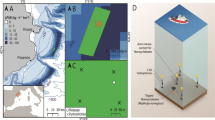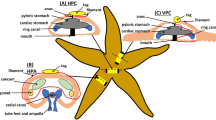Abstract
Observations have been made on the locomotory behaviour and swimming performances of the Norway lobster, Nephrops norvegicus (L.), fitted with an acoustic transmitter ventrally under the cephalothorax. The walking behaviour of adult males (≥44 mm carapace length) appeared to be unaffected, but the tag caused significant reductions in certain measures of tail-flip swimming performance such as swimming speed and endurance. Flume-tank experiments in low water currents suggested that the transmitter would increase hydrodynamic drag during swimming by 9 to 32%, depending on lobster size. Given the weight and dimensions of the acoustic transmitters currently available, it is considered advisable to confine acoustic tracking studies to relatively large N. norvegicus.
Similar content being viewed by others
Literature cited
Alexander, D. E. (1990). Drag coefficients of swimming animals: effects of using different reference areas. Biol. Bull. mar. biol. Lab., Woods Hole 179: 186–190
Arnold, G. P., Holford, B. H. (1979). The physical effects of an acoustic tag on the swimming performance of plaice and cod. J. Cons. int. Explor. Mer 38: 189–200
Bottoms, A., Marlow, J. (1979). A new ultrasonic tag for the telemetry of physiological functions from aquatic animals. Mar. Biol. 50: 127–130
Chapman, C. J., Johnstone, A. D. F., Rice, A. L. (1975). The behaviour and ecology of the Norway lobster, Nephrops norvegicus (L.). Proc. 9th Eur. mar. Biol. Symp. 59–74. [Barnes, H. (ed.) Aberdeen University Press, Aberdeen]
Harden Jones, F. R., Margetts, A. R., Greer Walker, M., Arnold, G. P. (1977). The efficiency of the Granton otter trawl determined by sector-scanning sonar and acoustic transponding tags. Rapp. P.-v. Réun. Cons. perm. int. Explor. Mer 170: 45–51
Hargreaves, B. R. (1981). Energetics of crustacean swimming. In: Herreid, C. F., Fortner, C. R. (eds.) Locomotion and energetics in arthropods. Plenum Press, New York, p. 453–490
Hawkins, A. D., Urquhart, G. G. (1983). Tracking fish at sea. In: MacDonald, A. G., Priede, I. G. (eds) Experimental biology at sea. Academic Press, London, p. 103–166
Hill, B. J. (1978). Activity, track and speed of movement of the crab Scylla serrata in an estuary. Mar. Biol. 47: 135–141
Howard, F. G., Hall, W. B. (1983). Some observations on the biometrics of Nephrops norvegicus (L.) in Scottish waters. Int. Counc. Explor. Sea Comm. Meet. (Shellfish, Benthos Comm.) K:36: 1–4 (mimeo)
Lang, F., Govind, C. K., Costello, W. J., Greene, S. L. (1977). Developmental neuroethology: changes in escape and defensive behaviour during growth of the lobster. Science, N.Y. 197: 682–685
Main, J., Sangster, G. I. (1985). The behaviour of the Norway lobster, Nephrops norvegicus (L.) during trawling. Scott. Fish. Res. Rep. 34: 1–23
McCleave, J. D., Stred, K. A. (1975). Effect of dummy telemetry transmitters on stamina of Atlantic salmon (Salmo salar) smolts. J. Fish. Res. Bd Can. 32: 559–563
Monan, G. E., Thorne, D. L. (1973). Sonic tags attached to Alaska king crab. Mar. Fish. Rev. 35: 18–21
Newland, P. L., Chapman, C. J. (1989). The swimming and orientation behaviour of the Norway lobster, Nephrops norvegicus (L.), in relation to trawling. Fish. Res. 8: 63–80
Newland, P. L., Chapman, C. J., Neil, D. M. (1988a). Swimming performance and endurance of the Norway lobster Nephrops norvegicus. Mar. Biol. 98: 345–350
Newland, P. L., Neil, D. M. (1990). The tail flip of the Norway lobster, Nephrops norvegicus. I. Giant fibre activation in relation to swimming trajectories. J. comp. Physiol. (Sect. A) 166: 517–527
Newland, P. L., Neil, D. M., Chapman, C. J. (1988b). The reactions of the Norway lobster, Nephrops norvegicus (L.), to water currents. Mar. Behav. Physiol. 6: 301–313
Stasko, A. B., Pincock, D. G. (1977). Review of underwater biotelemetry, with emphasis on ultrasonic techniques. J. Fish. Res. Bd Can. 34: 1261–1285
Wolcott, T. G., Hines, A. H. (1989). Ultrasonic biotelemetry of muscle activity from free-ranging marine animals: a new method for studying foraging by blue crabs (Callinectes sapidus). Biol. Bull. mar. biol. Lab., Woods Hole 176: 50–56
Author information
Authors and Affiliations
Additional information
Communicated by J. Mauchline, Oban
Correspondence to: C. J. Chapman
Rights and permissions
About this article
Cite this article
Newland, P.L., Chapman, C.J. Locomotory behaviour and swimming performance of the Norway lobster, Nephrops norvegicus, in the presence of an acoustic tag. Marine Biology 115, 33–37 (1993). https://doi.org/10.1007/BF00349383
Received:
Accepted:
Issue Date:
DOI: https://doi.org/10.1007/BF00349383




